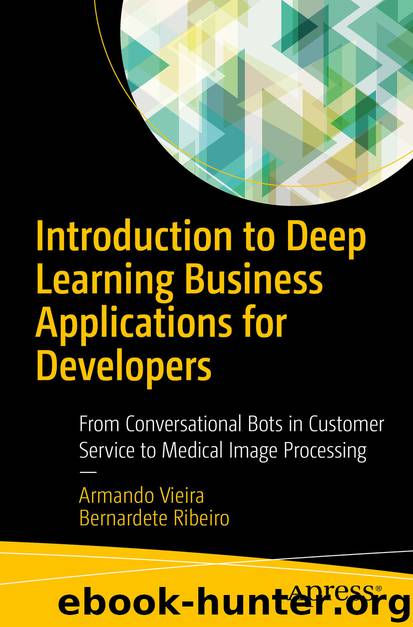Introduction to Deep Learning Business Applications for Developers by Armando Vieira & Bernardete Ribeiro

Author:Armando Vieira & Bernardete Ribeiro
Language: eng
Format: epub
Publisher: Apress, Berkeley, CA
7.1 Online User Behavior
Predicting user intentionality (the desire to buy a given product or service), based on previous interactions within a web site, is critical for e-commerce and ad display networks, in particular retargeting. By keeping track of the search patterns of the consumers , online merchants can have a deep understanding of their behaviors and intentions.
In mobile e-commerce, a rich set of data is available, and potential consumers search for product information before making purchasing decisions, thus reflecting a consumer’s purchase intentions. Users show different search patterns (i.e., time spent per item, search frequency, and returning visits).
Clickstream data can be used to quantify search behavior using machine learning techniques, mostly focused on purchase records. While purchasing indicates a consumer’s final preferences in the same category, search is also an essential component to measuring intentionality toward a specific category. You can use a probabilistic generative process to model user exploratory and purchase history, in which the latent context variable is introduced to capture the simultaneous influence from both time and location. By identifying the search patterns of consumers, you can predict their click decisions in specific contexts and recommend the right products.
Modern search engines use machine learning approaches to predict user activity within web content. Popular models include logistic regression (LR) and boosted decision trees . Neural networks have an advantage over LR because they are able to capture nonlinear relationship between the input features and because their “deeper” architecture has inherently greater modeling strength. Decision trees—albeit popular in this domain—face additional challenges with high-dimensional and sparse data. The advantage of probabilistic generative models inspired by deep neural networks is that they can mimic the process of a consumer’s purchase behavior and capture the latent variables to explain the data.
In my 2016 paper, I proposed ( https://arxiv.org/pdf/1511.06247.pdf ) an algorithm based on auto-encoders to identify the activity patterns of certain users that led to buy sessions and then extrapolated as templates to predict high probabilities of purchase in related web sites. The data used consists of about 1 million sessions containing the click data of users. However, only 3 percent of the training data consists of buy sessions, making it a very unbalanced dataset. To handle this, I used an under-sampling technique (i.e., selecting only a fraction of negative examples).
Download
This site does not store any files on its server. We only index and link to content provided by other sites. Please contact the content providers to delete copyright contents if any and email us, we'll remove relevant links or contents immediately.
| Computer Vision & Pattern Recognition | Expert Systems |
| Intelligence & Semantics | Machine Theory |
| Natural Language Processing | Neural Networks |
Algorithms of the Intelligent Web by Haralambos Marmanis;Dmitry Babenko(8586)
Test-Driven Development with Java by Alan Mellor(7543)
Data Augmentation with Python by Duc Haba(7431)
Principles of Data Fabric by Sonia Mezzetta(7195)
Learn Blender Simulations the Right Way by Stephen Pearson(7123)
Microservices with Spring Boot 3 and Spring Cloud by Magnus Larsson(6941)
RPA Solution Architect's Handbook by Sachin Sahgal(6349)
The Infinite Retina by Robert Scoble Irena Cronin(6056)
Hadoop in Practice by Alex Holmes(6055)
Jquery UI in Action : Master the concepts Of Jquery UI: A Step By Step Approach by ANMOL GOYAL(5911)
Big Data Analysis with Python by Ivan Marin(5830)
Life 3.0: Being Human in the Age of Artificial Intelligence by Tegmark Max(5447)
Pretrain Vision and Large Language Models in Python by Emily Webber(4786)
Infrastructure as Code for Beginners by Russ McKendrick(4560)
WordPress Plugin Development Cookbook by Yannick Lefebvre(4273)
The Age of Surveillance Capitalism by Shoshana Zuboff(4192)
Functional Programming in JavaScript by Mantyla Dan(4166)
Embracing Microservices Design by Ovais Mehboob Ahmed Khan Nabil Siddiqui and Timothy Oleson(4055)
Applied Machine Learning for Healthcare and Life Sciences Using AWS by Ujjwal Ratan(4037)
